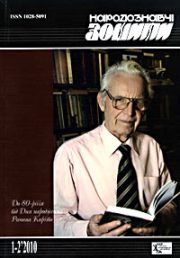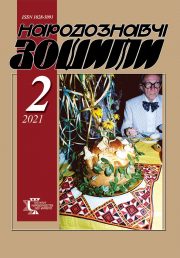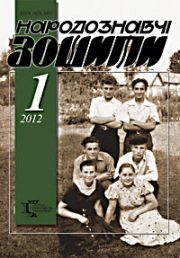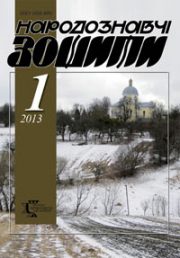The Ethnology Notebooks. 2020. № 1 (151), 93—108
UDK738.8(477.83-25)”18/19″
DOI https://doi.org/10.15407/nz2020.01.093
IVASHKIV Halyna
ORCID ID: http://orcid.org/0000-0003-2359-6735
Candidate of Sciences in Art Studies,
Senior Researcher
Museum of Ethnography and Crafts
Institute of Ethnology
National Academy of Sciences of Ukraine,
15, Svobody Avenue, 79000, Lviv, Ukraine,
Contacts: e-mail: halia_503@ukr.net
Abstract. The article deals with the sacral earthenware that was produced on the factory of the famous architect, professor of Lviv Polytechnic, manufacturer and philanthropist Ivan Levynskyy (1851–1919), whose 100th death anniversary we commemorated in 2019.
The given question seems rather topical, since it has never been examined before in a separate paper. The aim of this article is to carry out an art critical research into the earthenware used for church and ritual purposes of the late 19th – early 20th cc. from Ivan Levynskyy’s factory. In particular, the paper will concentrate on the typology of earthenware items, their shapes and dйcor. The object of our research is manufactured earthenware which is kept in Lviv museums, while the object of the paper includes sacral functions, Christian motives and images on ceramics. The article is methodologically based on the principles of systematicity, historism and comparativism, applying cultural and historical as well as comparative and typological methods.
Ivan Levynskyy brought up a wide row of Ukrainian and Polish architects and builders who introduced fresh Secession notes into the “architectural face” of not only Lviv, but also whole Halychyna in the late 19th – early 20th cc. In exteriors and interiors of churches, houses of famous people, buildings of various societies, health retreats, People’s Halls and hospitals the architects skillfully used metal railing, majolica tiles or terracotta panels, relief compositions, sculptures, ornamental bricks and coloured roof tiles. All the above-mentioned elements made every building outstanding and recognizable among architectural works by other authors.
Among the earthenware that was manufactured on the factory, we can single out early 20th c. plates with the motive of a cross or combination of crosses, with the image of St. Nicholas, a plaque «Jesus Christ», some icon cases (they were made of wood, majolica tiles and images of Jesus Christ with the angels), as well as earthenware icons with the plot “Coronation of Virgin Mary” (three icons by Oleksandr Lushpynskyy survived). The author has also characterized artistic specificity of a handheld terracotta cross, communion plates, altar and floor-standing candlesticks (many of them were made by Mykhaylo Lukiyanovych), as well as vases decorated with painted Christian symbols. A number of similar items were also produced by certain Ukrainian potters of the late 19th – early 20th cc., ceramic schools and manufactures. Apart from that, I. Levynskyy’s factory produced some items for Easter rituals, namely Easter eggs, only four of which survived. All the items of religious nature that were produced on Ivan Levynskyy’s factory reflect an outstanding style of talented authors and a high quality of the materials.
Keywords: Ivan Levynskyy, factory, earthenware, icon case, icon, cross, communion plate, candlestick, Easter egg.
Received 20.01.2020
REFERENCES
Oleksyn, I. (1934) Life and work of Ivan Levynskyy. Ivan Levynskyy: his life and work. Lviv: Printed by Ivan Levynskyy Agronomical and Technical Society «Pratsia» in Lviv [in Ukrainian]
Kornellya, А. (1934) «He was carving people’s souls with the strength of his character, the hammer of his energy and the blood of his heart». Ivan Levynskyy: his life and work. Lviv: Printed by Ivan Levynskyy Agronomical and Technical Society «Pratsia» in Lviv [in Ukrainian]
Noha, O. (2001) Ukrainian artistic and manufactured ceramics of Halychyna (1840–1940). Lviv: Ukrayinski tekhnolohiyi [in Ukrainian]
Shukhevych, V. Participation of the Ruthenians in the industrial and lithurgical exhibition. Dilo. 17 July, 1909. Part 154 [in Ukrainian]
Noha, O. (1993) Ivan Levynskyy. An artist, an architect, an entrepreneur, a teacher and a public figure. Lviv: Osnova [in Ukrainian]
Noha, O. (2009) Ivan Levynskyy. An architect, an entrepreneur and a philanthropist. Lviv: Tsentr Yevropy [in Ukrainian]
Shmahalo, R. (1994) Sacral function in Ukrainian earthenware of the 19th — early 20th cc. Ukrainian sacral art: traditions, nowadays and perspectives. Papers of the International Scholarly Conference (Lviv, May 4—5, 1993). Lviv: Svichado [in Ukrainian]
Shmahalo, R. (2005) Art education in Ukraine of the mid 19th — mid 20th cc. Structuring, methodology and artistic positions. Lviv: Ukrayinski tekhnolohiyi [in Ukrainian]
Birulyov, Yu. (2010) The Zakharevychi: Creators of the capital city Lviv. Lviv: Tsentr Yevropy [in Ukrainian].
Birulyov, Yu. О. (2017) Mykhaylo Lukiyanovych. Encyclopedia of contemporary Ukraine. Kyiv, vol. 18 [in Ukrainian]
Kolupayeva, А. (2004) Ukrainian earthenware in the sacral sphere. Zapysky Naukovoho Tovarystva imeni Shevchenka. Vol. ССХLVІІІ. Papers by the Committee for decorative art and arts and crafts. Lviv: Naukove Tovarystvo imeni Shevchenka [in Ukrainian]
Kolupayeva, А. (2012) To the history of church and ritual earthenware in Ukraine (the 11th — early 21st cc.). Narodoznavchi zoshyty. № 3 [in Ukrainian]
Ivashkiv, H. (2007) To the question of earthenware communion plates: shape and decor. Istoriya relihiy v Ukrayini. Naukovyy shchorichnyk. 2007. Lviv: Lohos. Book 1 [in Ukrainian]
Ivashkiv, H. (2007) The decor of Ukrainian folk ceramics of the 16th — first half of the 20th cc. Lviv: The Ethnology Institute at NAS of Ukraine [in Ukrainian]
Ivashkiv, H. (2008) Earthenware iconostases, reliefs and icons. Istoriya relihiy v Ukrayini. Naukovyy shchorichnyk. 2008. Lviv: Lohos. Book 2 [in Ukrainian]
Ivashkiv, H. (2008) Functions, typology and artistic specificity of earthenware crosses in Ukraine. Narodoznavchi zoshyty. № 1—2 [in Ukrainian]
Ivashkiv, H. (2009) Earthenware crosses: their functions, typology and decor. Istoriya relihiy v Ukrayini. Naukovyy shchorichnyk. 2009: in 2 books. Lviv, Book 2 [in Ukrainian]
Ivashkiv, H. (2009) Lithurgical earthenware crosses. Visnyk Prykarpatskoho universytetu. Mystetstvoznavstvo. Ivano-Frankivsk, No. 14 [in Ukrainian]
Ivashkiv, H. (2010) Petro Linynskyy’s collection of ceramics. Lviv: The Ethnology Institute at NAS of Ukraine [in Ukrainian]
Ivashkiv, H. (2012) The earthenware in the Holy Mass ritual. Narodoznavchi zoshyty. № 3 [in Ukrainian]
Ivashkiv, H. (2012) Earthenware floor-standing candlesticks of the 19th —20th cc.: their typology and artistic structure. Mystetstvoznavstvo‘12. Lviv: SKIM [in Ukrainian]
Lehin, S. The history of St. Andrew’s Church in Klepariv. Retrieved from: http:// photo-lviv.ua/istoriya-zvedennya-tserkvisv-andreya-pervozvannego-na-kleparovi [in Ukrainian]
A display of home crafts in Kolomyya on September, 21–30 1912. A catalogue. (1912) Kolomyya, printed by the exhibition committee [in Ukrainian]
Lukiyanovych, D. (1912) The display of home crafts in Kolomyya. Nedilya. Part 37 [in Ukrainian]
MEC.
NML. NK-1532.
Melegati, L. (1997) Ceramics. Warsaw [in Polish]
Reinfuss, R. (1966) Folk painted tiles. Krakow [in Polish]
Haberlandt, M. (1910) Austrian folk art from collections at museums of Austrian folk art in Wien. Wien. Tab. 60 (12). [in German]
Slobodyan, О. (2004) Pistyn ceramics of the 19th – first half of the 20th cc. Kosiv, Chernivtsi [in Ukrainian]
NMUFDA. K-573.
NMUFDA. Exposition.
CRHM. Exposition
SLM. Exposition.
SRAM. Exposition.
SRRM. Exposition.
NMHU. К-504.
NMUFDA. Exposition.
SRAM. Exposition.
Kyiv-Mezhyhirya porcelain. From the collection of the National Museum of Ukrainian Folk Decorative Art. (2017) Kharkiv: Rarytety Ukrayiny [in Ukrainian]
MEC. EP 68671.
Ohiyenko, I. (1992) Ukrainian culture. A brief history of culture life of the Ukrainian people. Kyiv [in Ukrainian]
Novytskyy, О. (1926) Symbolic images on the engravings of Kyiv first printed books. Zapysky Naukovoho Tovarystva imeni Shevchenka. Vol. СХLІV–СХLV. Papers by the Historical and Philosophical Section. Lviv [in Ukrainian]
MEC. EP 45078.
MEC. EP 45153.
MEC. EP 45152
MEC. EP 45077.
MEC. EP 45108.
MEC. EP 45107.
MEC. EP 45095.
MEC. EP 45088.
MEC. EP 45173.
MEC. EP 45164.
MEC. EP 45185.
MEC. EP 47171.
MEC. EP 47186.
In the manufactures of the architect Ivan Levynskyy and the Union. (1899) Czasopismo Techniczne. № 3. Year ХVІІ [in Polish]
MEC. EP 45302.
MEC. EP 45296.
MEC. EP 45236.
NMHPFA. Кr-2727/3.
MEC. EP 45333.
MEC. EP 45089.
MEC. EP 45151.
NMUFDA.
NMFARL.
SRAM. F-330.
NMFARL.
SRAM. F-329.







